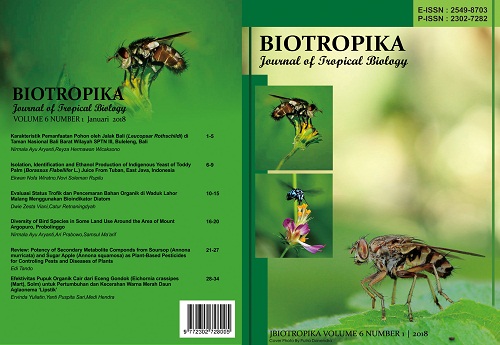Review: Potency of Secondary Metabolite Componds from Soursop (Annona murricata) and Sugar Apple (Annona squamosa) as Plant-Based Pesticides for Controling Pests and Diseases of Plants
DOI:
https://doi.org/10.21776/ub.biotropika.2018.006.01.5Keywords:
secondary metabolism, pesticide plant, soursop, sugar apple.Abstract
Indonesia is one country that is rich will flora and fauna which are biological resources. Plant secondary metabolites is a resource that is used for drugs. Besides can be extracted directly from the plant, also can be synthesized to obtain chemical compounds or their derivatives, through the development of cell culture. The impact of the use of synthetic pesticides / chemicals have an impact that is not good for health and cause disruption of the ecological balance. This paper aims to determine the potential utilization of secondary metabolites in plant soursop (Annona murricata) and sugar apple (Annona squamosa) as botanical pesticides to control pests and plant diseases. Plants soursop (Annona muricata) and sugar apple (Annona squamosa) has potential as a pesticide plant in controlling pests and diseases in plants. Results of phytochemical screening on extracts of leaves of the soursop (Annona muricata) found secondary metabolites: alkaloids, flavonoids, terpenoids, coumarin and lactones, anthraquinone, tannins, glycosides, phenols, phytosterols, and saponins, while the detection of the presence of a group of chemical compounds in seed extracts Soursop ( Annona muricata) and sugar apple (Annona squamosa), found secondary metabolites: alkaloids, flavonoids, polyphenols, terpenoids, coumarin, steroids, lactones, anthraquinone, tannins, glycosides, and saponins cyanadin. Natural pesticides are reducing pests, but is not directly Plant Pest Organisms (PPO) pests quickly. Natural pesticide application with the correct dose, can reduce pests, reduce costs and be environmentally friendly.References
Blunden, G. J.A. Jaffer. K. Jewers and W.J. Griffin. 1981, Steroidal sapogenins from leaves of Cordyline species, J. Nat. Prod. 44 (4): 441 – 447
Zhao J. C. Lawrence. Davis and V. Robert. 2005. Elicitor Signal Transduction Leading to Production of Plant Secondary Metabolites. Biotechnology Advances. 23: 283 -333.
Zhang C. Q. Yan. W. Cheuk. J. Wu. 2004. Enhancement of Tanshinone Production in Salvia Miltiorrhiza Hairy Root Culture by Ag+ elicitation and Nutrient Feeding. Planta Med. 70: 147 - 51.
Mariska I. 2013. Metabolit Sekunder: Jalur pembentukan dan kegunaannya. BB Biogen, Bogor. http://biogen.litbang.deptan.go.id/index.php/2013/08/metabolit-sekunder-jalur-pembentukan-dan-kegunaannya/
Schultz, J.C. 2002. Biochemical ecology: How plants fight dirty. Nature. 416: 267
Pavarinia D.P. P. Saulo Petinatti. N. Michael. L. Norberto Peporine. 2012. Exogenous influences on plant secondary metabolite levels. J. Animal Feed Science and Technology. 176: 5 - 16
Gavamukulya Y. E. Faten Abou. W. Fred. A. Hany. 2014. Phytochemical Screening, Anti-Oxidant Activity and In Vitro Anticancer Potential of Ethanolic and Water Leaves Extracts of Annona muricata (Graviola). Asian Pac. J. Trop Med. 7(Suppl 1): S355 - S363
Ukwubile CA. 2012. Phytochemical Screening and Anti-Ovarian Cancer Properties of Annona muricata Linn (Annonaceae) Seed Ethanol Extract. Int J. Pharm. Front. Res. 2: 9-17.
Komansilan A, AL. Abadi. B. Yanuwiadi. DA. Kaligis. 2012. Isolation and Identification of Biolarvicide From Soursop (Annona muricata Linn) Seeds to Mosquito (Aedes aegypti) Larvae. Int. J. Eng Technol. 12 (03): 28 - 32
Fong EH. W. Tin Wa. NR. Farnsworth. RH. Dobberstein. 1977. Phytochemical Screening Methods (Laboratory Manual). Chicago: College of Pharmacy, University of Illinois at the Medical Center.
Ravaomanarivo L.H.R. R. Herisolo Andrianiaina. R. Fara Nantenaina. R. Beby. R. Pierre Hervé. M. Patrick. 2014. Efficacy of Seed Extracts of Annona squamosa and Annona muricata (Annonaceae) for the Control of Aedes albopictus and Culex quinquefasciatus (Culicidae). Asian Pac J. Trop Biomed. 4 (10): 798 - 806
Astuti U.P. T. Wahyuni dan B. Honorita. 2013. Petunjuk Teknis Pembuatan Pestisida Nabati Mendukung Pengembangan Kawasan Rumah Pangan Lestari di Provinsi Bengkulu. Balai Pengkajian Teknologi Pertanian Bengkulu. Kementrian Pertanian. 1-70 h.
Kardinan, A. 2002. Pestisida Nabati: Ramuan dan aplikasi. Cetakan ke-4. Penebar Swadaya, Jakarta. 88 hlm.
Tohir, A.M. 2010. Teknik Ekstraksi dan Aplikasi Beberapa Pestisida Nabati untuk Menurunkan Palatabilitas Ulat Grayak (Spodoptera litura Fabr.) di Laboratorium. Buletin Teknik Pertanian. 15 (1): 37-40.
Downloads
Published
Issue
Section
License
Copyright and Attribution:
Articles in Biotropika: Journal of Tropical Biology are under Creative Commons Attribution-NonCommercial (CC-BY-NC) copyright. The work has not been published before (except in the form of an abstract or part of a published lecture or thesis) and it is not under consideration for publication elsewhere. When the manuscript is accepted for publication in this journal, the authors agree to the automatic transfer of the copyright to the publisher.
![]() Journal of Biotropika: Journal of Tropical Biology is licensed under a Creative Commons Attribution-NonCommercial 4.0 International (CC BY-NC 4.0).
Journal of Biotropika: Journal of Tropical Biology is licensed under a Creative Commons Attribution-NonCommercial 4.0 International (CC BY-NC 4.0).
Permissions:
Authors wishing to include figures, tables, or text passages that have already been published elsewhere and by other authors are required to obtain permission from the copyright owner(s) for both the print and online format and to include evidence that such permission has been granted when submitting their papers. Any material received without such evidence will be assumed to originate from one of the authors.
Ethical matters:
Experiments with animals or involving human patients must have had prior approval from the appropriate ethics committee. A statement to this effect should be provided within the text at the appropriate place. Experiments involving plants or microorganisms taken from countries other than the author's own must have had the correct authorization for this exportation.

















